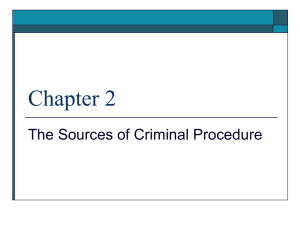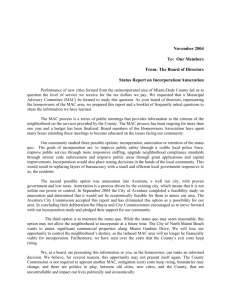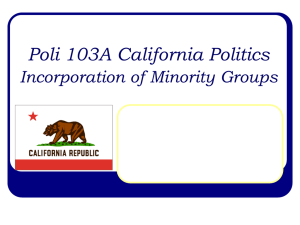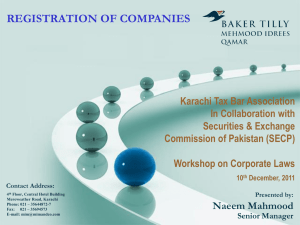Technology Planning
advertisement
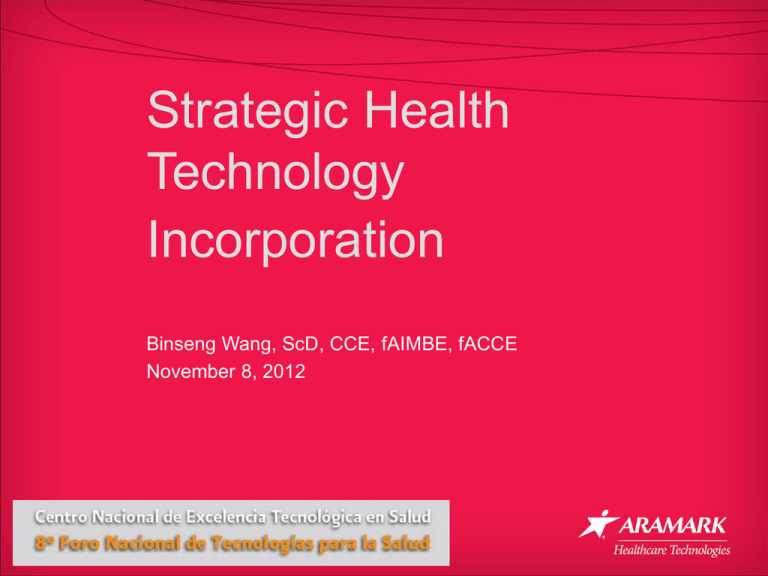
Strategic Health Technology Incorporation Binseng Wang, ScD, CCE, fAIMBE, fACCE November 8, 2012 ¡Gracias por tu invitación! • It is an honor for me to be here to exchange ideas and experience with you. • It would be presumptuous of me to teach you anything about technology incorporation because I know you have being doing it for almost a decade (and confirmed by the Discussion Panel on Tuesday). • I hope to incorporate your experience in the next revision of my book on this subject. • I also want to apologize for my inability to speak Spanish correctly. 2 MOTIVATION • According to the World Health Organization - WHO* Up to three quarters of these [medical] devices do not function in their new settings and remain unused. Factors contributing to this are: lack of needs assessment, appropriate design, robust infrastructure, spare parts when devices break down, consumables, and a lack of information for procurement and maintenance, as well as trained health-care staff. Now that Mexico is providing universal health coverage for all (Seguro Popular), how will it manage technology in a safe, cost effective manner? COUNTRY Europe USA Mexico (estimated) THE/Capita (€) MTE/Capita (€) 2,173 145 5,098 330 1,300 117 *WHO, Medical devices: managing the Mismatch, Geneva 2010 THE = total healthcare expenditure MTE = medical technology expenditure 3 MTE/THE (%) MTE (€ billion) 6.66% 72.57 6.48% 97.96 9.00% 13.45 CONTENTS • INTRODUCTION • CONCEPTUAL FRAMEWORK • STRATEGIC INCORPORATION PROCESS – Strategic Planning – Strategic Acquisition • OUTCOME EVALUATION • DISCUSSION – Misconceptions – Challenges • CONCLUSIONS 4 Reference • Binseng Wang Strategic Health Technology Incorporation, Morgan and Claypool Publishers, 2009 • Binseng Wang Medical Equipment Maintenance: Management and Oversight, Morgan and Claypool Publishers, 2012 5 Other Publications • Wang B, Fedele J, Pridgen B, Rui T, Barnett L, Granade C, Helfrich R, Stephenson B, Lesueur D, Huffman T, Wakefield JR, Hertzler LW & Poplin B. Evidence-Based Maintenance: I - Measuring maintenance effectiveness with failure codes, J Clin Eng, July-Sept 2010, 35:132144. • Wang et al. Evidence-Based Maintenance: II - Comparing maintenance strategies using failure codes, J. Clin. Eng., Oct-Dec 2010, 35:223-230 • Wang et al. Evidence-Based Maintenance: III - Enhancing patient safety using failure code analysis, J. Clin. Eng., Apr-June 2011, 36:72-84 • Wang et al. Evidence-Based Maintenance: IV – Comparing maintenance procedures using failure codes, in preparation 6 INTRODUCTION Political Leaders Health Leaders Patients Vendors Competitors 7 Health Technology Costs • Equipment costs (depreciation, maintenance, etc.) is actually the lowest of all health technologies Mean Per Discharge Cost (%Total Hosp per Discharge Cost) 15% 10% 5% 0% Drugs Implants • Wang et al., Financial Impact of Medical Technology, IEEE Eng Med Biol magazine, 27(4):80-85, Jul/Aug 2008. • Maeda et al., What Hospital Inpatient Services Contributed the Most to the 2001-2006 Growth in the Cost per Case? Health Serv Res, 47:1814– 8 1835, 2012 Other Supplies Clin Eng Strategic Health Technology Incorporation Global Mission & Goals Patients’ Needs Strategic Health Technology Incorporation Process Market Pressure 9 Technology Incorporation Plan CONCEPTUAL FRAMEWORK • Health technology is nothing but a tool. It has little intrinsic value but can be invaluable in providing high-quality care in a cost-effective way if used by the right person(s) at the right time and in the right manner. Health Technology Needs + Benefits Impacts • patients • users • infrastructure • costs • clinical • operational • financial 10 Technology Lifecycle from Different Perspectives clinical trials early adoption possible loss mass adoption high revenue Regulatory approval products produced USER’S PERSPECTIVE obsolescence low revenue time (years) PRODUCER’S PERSPECTIVE R&D investment Marketing & Distribution high profit medium profit 11 low profit Health Policy Cycle Evaluation ETHICS Problem Definition POLITICS Implementation Diagnosis Political Decision Policy Development Adapted from Hsiao et al., Getting Health Reform Right, Harvard Univ./World Bank Inst., 2000 12 Technology Management Lifecycle Health Policy (Mission & Vision) Strategic Planning Technology Assessment Regulations & Standards Market Competition Financial Constraints Epidemiological Data feedback Installation/Acceptance Maintenance & Management Manufacturers & Distributors Service Suppliers Acquisition Clinical Use Architects Information Technology Utilization Standards Quality Improvement & Risk Management Retirement 13 Facilities Management Material Management Total Cost of Ownership (TCO) Initial Investment - Equipment price - Accessories - Shipping, insurance & customs - Installation < 20% of Total Cost of Ownership (TCO) Invisible Costs - Operations - Maintenance - Administrative - User learning > 80% of TCO 14 CONTENTS • INTRODUCTION • CONCEPTUAL FRAMEWORK • STRATEGIC INCORPORATION PROCESS – Strategic Planning – Strategic Acquisition • OUTCOME EVALUATION • DISCUSSION – Misconceptions – Challenges • CONCLUSIONS 15 STRATEGIC INCORPORATION PROCESS Technology Planning Technology Audit Technology Evaluation Technology Plan Evaluation Consolidation Technology Acquisition Technology Management Procurement Product Selection Installation Acceptance Alternatives to Purchasing 16 Resources for Technology Incorporation Organization Board or CEO Chief Medical Officer Chief Nursing Officer Chief Finance Officer Chief Operations Officer Clinical Engineering Health Policy (mission, vision, strategies, etc. Technology Assessment Regulations & Standards Market Competition Financial Constraints Epidemiological Data Technology Incorporation Committee Admin Support Task Force 1 Technical Support Task Force 2 Facilities Mgmt Task Force 3 Information Technology 17 Architects Manufacturers Other Suppliers Material Mgmt Technology Planning • Technology Audit Technology Planning Technology Audit – Inventory – Condition – Distribution Technology Evaluation • Technology Evaluation – – – – Need assessment Impact assessment Costs assessment Benefits assessment • Evaluation Consolidation • Technology Plan 18 Evaluation Consolidation Technology Plan Strategic Considerations • Included in the Benefits Assessment as “indirect” benefits • Examples: – Maternal-child care emphasis => OBGY & neonatal technologies – Disease prevention => cold chain for vaccine storage & distribution – Surgical revenue => improvement in diagnostic technologies – Market competitiveness => surgical robots • In other words, “strategic” means to look beyond immediate needs and consider broader and longer vision 19 Sample Evaluation Summary Clinical Financial Indirect -2.0 -1.5 -1.5 -1.0 -3.0 -1.0 -2.5 -1.0 -1.5 -4.0 -2.0 0.0 Users -1.5 2.0 -3.0 -1.0 -1.5 1.0 -1.0 2.0 -1.0 -3.0 -2.0 0.0 Recurrent 0.0 0.0 0.0 -0.5 -2.0 -1.0 -1.0 0.0 0.0 -4.0 0.0 -1.0 COSTS EVAUATION BENEFITS EVALUATION TOTAL INVESTMENT CUMULATIVE SCORE COST (US$) COST (US$) Investment Maintenance 3.5 3.0 3.0 4.5 2.5 2.5 3.0 2.5 1.5 2.0 -2.0 -1.0 Users 1 Video-endoscopy for lower GI 2 YAG surgical laser 3 Cardiac ultrasound system 4 Endoscope washer and disinfection 5 Automated chemistry analyzer 6 Surgical light 7 intra-aortic balloon pump 8 250 general purpose infusion pumps 9 Video-endoscopy for upper GI 10 Second CT scanner (64 slice) 11 Phaco-emulsifier for eye surgery 12 Surgical table NEED IMPACT EVALUATION EVALUA TION Infrastructure ITEM EQUIPMENT BEING EVALUATED -1.0 -2.5 -3.0 -1.0 -3.0 -2.0 -2.0 -3.5 -1.0 -5.0 -1.0 -2.0 -1.0 -2.0 -1.5 -2.0 -3.0 0.0 -2.0 -2.0 -1.0 -3.5 -1.0 0.0 -2.0 -2.0 -2.0 -2.0 -2.0 0.0 -1.0 -2.0 -2.0 -3.0 -3.0 0.0 3.0 2.0 3.0 2.0 5.0 2.0 3.0 3.0 1.0 4.0 2.0 1.0 5.0 4.0 2.0 2.0 3.0 1.0 1.5 1.0 1.0 2.0 2.0 1.0 3.0 3.0 4.0 1.0 2.0 0.0 1.0 0.0 2.0 5.0 3.0 0.0 The 2nd CT could be a strategic initiative but also could be something that will not provide good return on investment (ROI) 20 1.7 1.4 1.1 1.1 0.9 0.7 0.7 0.6 0.4 0.4 -0.1 -0.1 $20,000 $65,000 $60,000 $12,000 $250,000 $25,000 $50,000 $750,000 $20,000 $1,000,000 $55,000 $35,000 $20,000 $85,000 $145,000 $157,000 $407,000 $432,000 $482,000 $1,232,000 $1,252,000 $2,252,000 $2,307,000 $2,342,000 STRATEGIC TECHNOLOGY ACQUISITION • Product Selection – – – – Technology Acquisition Technical considerations Regulatory considerations Financial considerations Supplier considerations Procurement Product Selection Alternatives to Purchasing • Procurement – Isolated Purchasing – Group Purchasing – – – – – Lease Rental (short term lease) Consumable-purchase agreement Revenue-sharing agreement Donation 21 possible loss Regulatory approval • Alternatives to Purchasing products produced USER’S PERSPECTIVE clinical trials early adoption mass adoption high revenue obsolescence low revenue Product B Product A time (years) CONTENTS • INTRODUCTION • CONCEPTUAL FRAMEWORK • STRATEGIC INCORPORATION PROCESS – Strategic Planning – Strategic Acquisition • OUTCOME EVALUATION • DISCUSSION – Misconceptions – Challenges • CONCLUSIONS 22 OUTCOME EVALUATION • For health policy – Population health status – Population satisfaction – Financial risk protection FINANCING PROVIDER PAYMENT MECHANISMS ORGANIZATION REGULATION INTERMEDIATE OUTCOMES CHANGING INDIVIDUAL BEHAVIOR • Access • Quality • Equity • Efficiency • Health Status • Satisfaction • Financial Risk Protection FINAL OUTCOMES Adapted from Hsiao et al., Getting Health Reform Right, Harvard Univ./World Bank Inst., 2000 23 OUTCOME EVALUATION (Evidence-Based Technology Incorporation) • For health technology – Technology “health status” • % of technology in use • Global failure rate for equipment • Uptime for mission critical equipment • For health policy – Population health status – Population satisfaction – Financial risk protection – Technology impact • Mortality & morbidity reductions • Length of stay reductions • Patient incident reductions – Clinical user satisfaction – Financial impact • Reduction of unnecessary replacements & new capital investments • Reduction of maintenance costs 24 Medical Equipment Maintenance & Mgmt in USA 100,000 Major teaching Minor teaching Minor teaching Non-teaching Unknown $10,000 Total CE expense ($k) • Maintenance Costs (efficiency) • Reliability (effectiveness) Major teaching $100,000 Questionable 1% line $1,000 $100 r = .85 p < .0000001 Non-teaching Total # repair WOs Unknown $10 10,000 Questionable $10 1,000 r = .80 p < .0001 100 100 $100 $1,000 Total operating expenses ($M) 0.75 line 1,000 10,000 #Capital devices maintained 100,000 25 25 $10,000 Technology Must Be Well Managed After Incorporation Health Policy (Mission & Vision) Strategic Planning Technology Assessment Regulations & Standards Market Competition Financial Constraints Epidemiological Data feedback Installation/Acceptance Maintenance & Management Manufacturers & Distributors Service Suppliers Acquisition Clinical Use Architects Information Technology Utilization Standards Quality Improvement & Risk Management Retirement 26 Facilities Management Material Management Evidence-Based Maintenance - EBM A continual improvement process that analyzes the effectiveness of maintenance resources deployed in comparison to outcomes achieved previously or elsewhere and makes necessary adjustments to maintenance planning and implementation. Fishing = Process Catching = Outcome 27 EBM Strategy & Frequency Comparison 100% Estimated Annual Failure Probability (AFP) Pulse Oximeter F12 R/R Samp (#units: F12 = 522 ,R/R = 351, Samp = 251) 80% 10% 60% 5% 40% 0% 20% SIF HF PF PPF SIF HF PF PPF 0% No Fail UPF F12 = annual inspection R/R = repair or replace Samp = statistical sampling ACC BATT USE 28 EF NET EBM Procedure Comparison Multi-parameter Patient Monitor (#units: OEM = 338, Hospital = 920) Estimated Annual Failure Probability (AFP) 100% 80% 60% 40% OEM Hospital 20% 0% No Fail UPF ACC BATT USE OEM = manufacturer recommended procedure Hospital = hospital developed procedure 29 EF NET SIF HF PF PPF EBM Cause-Code Grouping Analyses Results Battery-Powered Mon/Pace/Defibrillator Vital Signs Monitors Direct 2% Direct 2% No Failure 35% Indirect 28% Indirect 47% No Failure 61% Future 9% Future 16% Single-Channel Infusion Pumps Pulse Oximeters Direct 3% Direct 1% No Failure 17% Indirect 22% Future 6% Indirect 56% No Failure 71% No failure = no problem found in SM or repair Future = unpreventable failure Indirect = use, peripheral, evident failure Direct = hidden, preventable, predictable, service-induced 30 Future 24% DISCUSSION: Misconceptions1 • Equipment life expectancy (aka “lifetime” or “usable life”) – Replace equipment before “end of life expectancy?” – How is reliability affected by life expectancy? – Besides the average life expectancy, shouldn’t you look at the standard deviations and individual cases? 100% Estimated Reliability 80% binary linear exponential 60% 40% 20% 0% 0 5 10 years after installation 31 15 DISCUSSION: Misconceptions2 • “End of Life” notices from manufacturers Should stop using equipment? Replace equipment as soon as possible? Ignore the notice? Evaluate “return on investment” for continual support and, if justified, include in the Strategic Equipment Planning? END OF LIFE Regulatory approval products produced – – – – time (years) PRODUCER’S PERSPECTIVE R&D investment Marketing & Distribution high profit medium profit low profit 32 See, e.g., M.N. Skoufalos, Numbered DaysExamining the true meaning of medical equipment ‘End of Life,’ Medical Dealer, Oct 2012, pp. 57-60. DISCUSSION: Misconceptions3 • “Maintenance Expenditure Limit” (MEL) US Army Tech Bulletin Med 7 states repairs shall NOT be conducted if the cost of repair exceeds the replacement cost multiplied by the percent of useful life remaining (limited between 10% and 65% for equipment that exceeded its life expectancy and has not exceeded 80%, respectively). MEL (% of Replacement Cost) 70 60 While repairs should NOT be conducted at any cost, it should also NOT be constrained rigidly to replacement cost, as capital budget is often separate from operating budget. 50 40 30 20 10 0 0% 20% 40% 60% 80% 100% % Useful Like Remaining 33 DISCUSSION: Misconceptions4 • Appropriate Technology (Equipment) was characterized by the Office of Technology Assessment (OTA) as: – A technology may be considered appropriate when its development and use: 1) are in reaction to or in anticipation of defined goals relating to problems or opportunities in the disability area, 2) are compatible with resource constraints and occur in an efficient manner, and 3) result in desirable outcomes with acceptable negative consequences or risks to parties at interest. – “Appropriate technology” or “appropriate application of technology” does not require that a technology be simple or that it be inexpensive, only that it be suitable for the intended effects and that it take into account any constraints, such as the resources available. – The most appropriate technology in a given situation is one that provides the greatest ratio of desirable outcomes to negative effects and resources consumed, providing that outcomes and consequences have been defined and are of sufficient value as judged by appropriate parties at interest. OTA, Technology and Handicapped People, May 1982 34 DISCUSSION: Misconceptions5 • Examples of Appropriate Technology that can be considered strategic in incorporation: – – – – Solar-powered refrigerators for vaccination campaigns Cellular telephones for rural healthcare Telemedicine for remote areas and prisons Water treatment systems for disaster relief (Mexico) • Better even than appropriate technology is technology (knowledge) transfer Give a man a fish and you feed him for a day. 35 Teach him to fish and you feed him for life. DISCUSSION: Challenges • Many challenges (opportunities) – Lack of accurate, reliable information (comparative performance, reliability, support costs, purchase costs, etc.) – Lack of trained purchasing and technical personnel – Many rules, regulations, and restrictions – Inflexible finance restrictions (can only buy equipment but not parts, only products made in certain countries, etc.) – Many others… • However, all these are fairly easy to resolve... 36 DISCUSSION: Challenges2 • The real challenges (i.e., the root causes) are more difficult – Lack of awareness among decision makers – Emotional involvement: • Power struggle • Status symbol – Greed and short-sightedness of some lenders, donation organizations, manufacturers and suppliers • Hope you have other solutions to share with me 37 CONCLUSIONS • Incorporation is not difficult: – Analyze carefully the need, impacts, costs, risks and benefits of each technology incorporation – Assess alternative technologies – Compare competitive products available on the market in terms of quality, specifications, and total cost of ownership – Use a multidisciplinary team to manage the procurement process to ensure all aspects are covered, as well as transparency – Analyze possible alternatives to acquisition • But you need to be willing and able to address the challenges 38 CONCLUSIONS2 • Technology is evolving extremely fast: – – – – – Electronic health records Telemedicine Telehomecare Mobile health Tissue engineering, nanotechnology, biomaterials, etc. – Synthetic biology – Organ re-growth and replacement Hardware & software Wetware • The sooner you start managing technology, the easier will be to face the on slaughter of new technologies But the good news is that you may have >100 years of work time as your life expectancy will be >150 years soon… 39 THANK YOU! ¡GRACIAS! • Please contact me if you have any questions or suggestions – Binseng Wang, ScD, CCE, fAIMBE, fACCE • Vice President, Quality & Regulatory Compliance • ARAMARK Healthcare Technologies (www.aramarkheatlhcaretechnologies.com) • Telephone: 704-948-5729 • Email: wang-binseng@aramark.com – Member of ACCE’s International Committee 40

